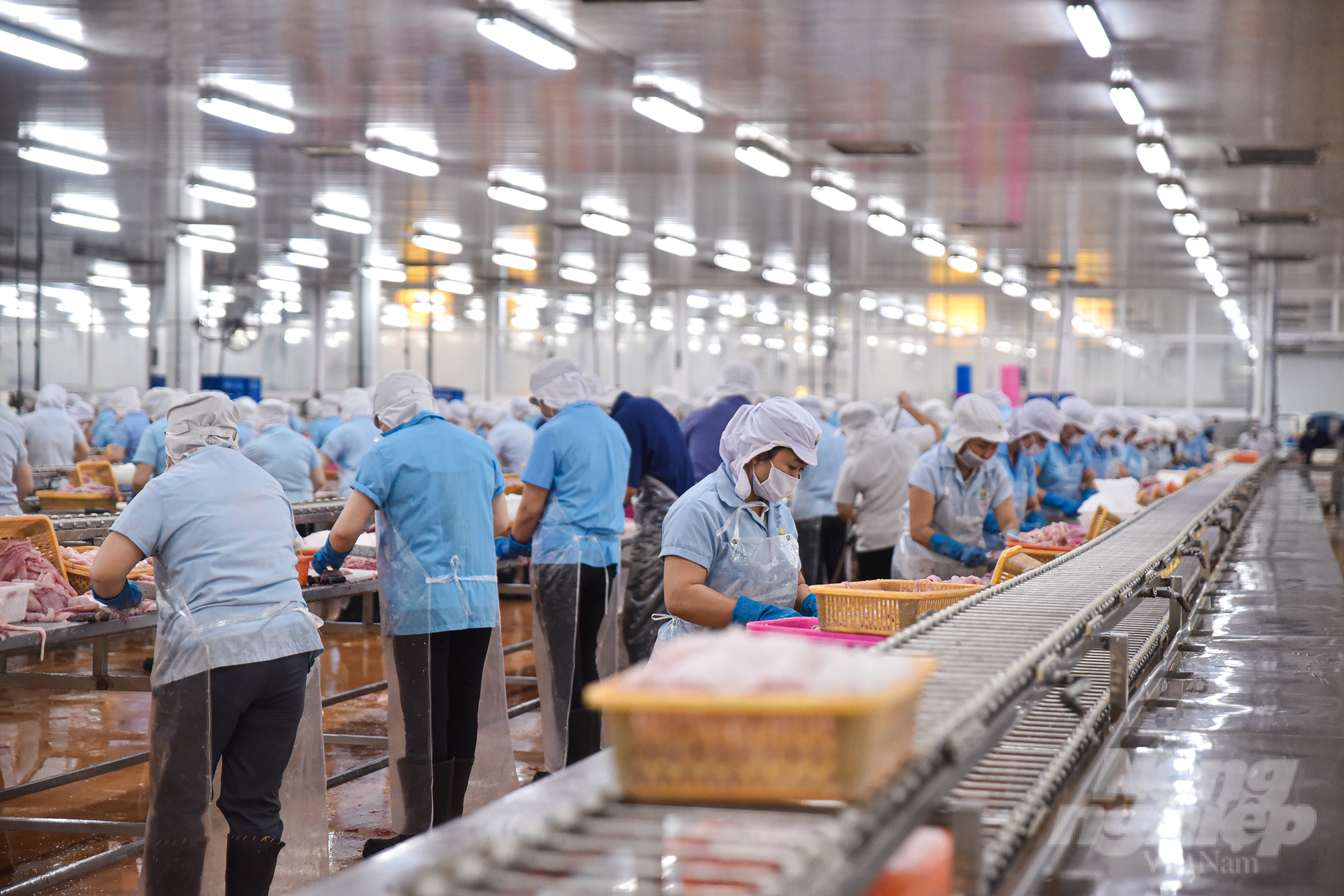April 13, 2025 | 23:48 GMT +7
April 13, 2025 | 23:48 GMT +7
Hotline: 0913.378.918
April 13, 2025 | 23:48 GMT +7
Hotline: 0913.378.918

On the occasion of the 30th anniversary of the Australian Center for International Agricultural Research (ACIAR) in Vietnam, the ACIAR delegation visits the Atlantic Ocean Processing Factory. This is one of four processing factories of Nam Viet Company, which has achieved many international quality certifications such as ISO, Global GAP, HACCP, IFS, among others.

In 30 years of establishment and development, Nam Viet Company has built a recirculating pangasius catfish production chain, working towards sustainable seafood development. As a partner of the project “Food Loss in the Pangasius Catfish Value Chain of the Mekong River Basin” project, Nam Viet Company wishes to receive support from ACIAR to soon upgrade its infrastructure and apply scientific techniques.

Fresh fish batches are poured into the factory for initial treatment. Raw pangasius are all alive, healthy, and not infected. After processing, the bones, skin, and organs are recycled into animal feed for pangasius. This process ensures that no part of the fish is wasted, avoiding loss in the pangasius value chain.

The processed fish is then transferred to the pangasius catfish sculpting workshop. There, workers preliminarily process pangasius into fillet, darne cut, and butterfly fish products according to orders from foreign customers. After that, fish fillets are washed, checked for parasites, and preliminarily classified by fish sizing machines, ensuring high capacity, efficiency, accuracy and cost savings.

The Atlantic Ocean Processing Factory has refined a closed value chain in aquaculture and seafood processing to ensure food safety, and avoid wasting raw materials and labor. Currently, the factory has about 1,200 employees.

After being washed multiple times, sized, and sculpted, pangasius fillets are transferred to a freezing room and cold storage. The freezing time is less than 4 hours, and the product center temperature should reach -180°C at the end of the freezing process.

Butterfly-cut pangasius products are taken out of the freezer and continue to be weighed and classified according to customer requirements.

Factory workers use an industrial vacuum packaging machine for frozen pangasius bags, preventing microorganisms, ensuring the quality of the finished product, and minimizing the packing storage.

Darne fish cuts are also classified by weight and size. The green basket contains standard-sized fish; the blue basket contains fish cuts larger than standard size; and the pink basket contains smaller cuts.

Quality standard fish products are packaged and transferred to the storage warehouse to wait for the export date. Currently, Nam Viet Company is the world’s second largest pangasius producer and exporter, delivering pangasius products to over 100 countries.

Before storing in the warehouse, factory employees are responsible for archiving information about the quantity, type of pangasius, production date, etc, to facilitate traceability and quality control of exported products.

To ensure the quality of pangasius materials, Nam Viet Company build a large farming area with a total area of about 600 hectares. With a large aquaculture area, managers are researching alternative methods of using factory and river water, limiting groundwater consumption, and avoiding landslides or subsidence.


Pangasius are fed twice a day. Nam Viet Company is actively testing solutions in aquaculture to deal with excess feed, sanitation and water safety. The managers look forward to ACIAR’s support in capacity building as well as science and technology applications.

Mr. David Whitehead, Senior Advisor of ACIAR Agribusiness Reference Group, shares his thoughts with the press at the visit to Nam Viet Company’s pangasius farming area. He commands the companies’ effort in applying high-tech pangasius farming and processing model, thereby standardizing a safe and thorough production process, and ensuring international traceability requirements.
Catfish (pangasius) is one of Vietnam's most valuable seafood imported into the US. Vietnam pangasius particularly claims a dominant market share in both volume and value.
Translated by Quynh Chi

(VAN) Businesses emphasize fairness and equality when integrating social factors into their sustainable development strategies.

(VAN) French organizations and enterprises propose that Thai Binh province provide potential and long-term cooperation contents related to climate change response and green industrial development.

(VAN) Shan Tuyet tea is considered a 'heavenly treasure'. The H'mong people allow the tea to grow naturally, adhering to organic production principles, with the aim of exporting the product.

(VAN) Bayer Vietnam and the National Agricultural Extension Center have signed a partnership agreement to expand the development of effective and safe farming models for rice, durian, and coffee.

(VAN) Tay Ninh province possesses all the favorable conditions, from natural advantages to geographic location and social harmony, to drive economic development, particularly in attracting investment and advancing modern livestock farming.

(VAN) Notably, every link in BAF's entire closed livestock value chain Feed - Farm - Food has received international certification.

(VAN) UOB Vietnam has recently signed a green credit agreement with NAVICO to develop sustainable aquaculture that meets international standards.